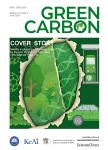Integration of advanced biotechnology for green carbon
作者机构:Key Laboratory of Fermentation Engineering(Ministry of Education)National"111"Center for Cellular Regulation&Molecular PharmaceuticsCooperative Innovation Center of Industrial Fermentation(Ministry of Education&Hubei Province)Hubei Key Laboratory of Industrial MicrobiologyBiomass&Bioenergy Research CenterHubei University of TechnologyWuhan 430068China College of Plant Science&TechnologyHuazhong Agricultural UniversityWuhan 430070China Shandong Provincial Key Laboratory of Energy GeneticsCAS Key Laboratory of BiofuelsQingdao Institute of Bioenergy&Bioprocess TechnologyChinese Academy of SciencesQingdao 266101China Shandong Energy InstituteQingdao 266101China
出 版 物:《Green Carbon》 (绿碳(英文))
年 卷 期:2024年第2卷第2期
页 面:164-175页
学科分类:08[工学] 09[农学] 0901[农学-作物学] 0836[工学-生物工程] 090102[农学-作物遗传育种]
基 金:supported by the National Natural Science Foundation of China(32170268 to L.P) the National 111 Project of the Ministry of Education of China(BP0820035 to L.P,D17009 to J.T) the Initiative Grant of Hubei University of Technology for High-level Talents(GCC20230001 to L.P) the Shandong Energy Institute,China(SEI I202142 to C.F)
主 题:Lignocellulose Biofuels Nanomaterials Nanocarbon Genetic engineering
摘 要:Carbon neutralization has been introduced as a long-term policy to control global warming and climate *** plant photosynthesis produces the most abundant lignocellulosic biomass on Earth,its conversion to biofuels and bioproducts is considered a promising solution for reducing the net carbon ***,natural lignocellulose recalcitrance crucially results in a costly biomass process along with secondary waste *** updating recent advances in plant biotechnology,biomass engineering,and carbon nanotechnology,this study proposes a novel strategy that integrates the genetic engineering of bioenergy crops with green-like biomass processing for cost-effective biofuel conversion and high-value *** selecting key genes and appropriate genetic manipulation approaches for precise lignocellulose modification,this study highlights the desirable genetic site mutants and transgenic lines that are raised in amorphous regions and inner broken chains account for high-density/length-reduced cellulose nanofiber assembly in *** the amorphous regions and inner-broken chains of lignocellulose substrates are defined as the initial breakpoints for enhancing biochemical,chemical,and thermochemical conversions,desirable cellulose nanofibers can be employed to achieve nearcomplete biomass enzymatic saccharification for maximizing biofuels or high-quality biomaterials,even under cost-effective and green-like biomass processes in *** study emphasizes the optimal thermal conversion for generating high-performance nanocarbons by combining appropriate nanomaterials generated from diverse lignocellulose ***,this study provides a perspective on the potential of green carbon productivity as a part of the fourth industrial revolution.



